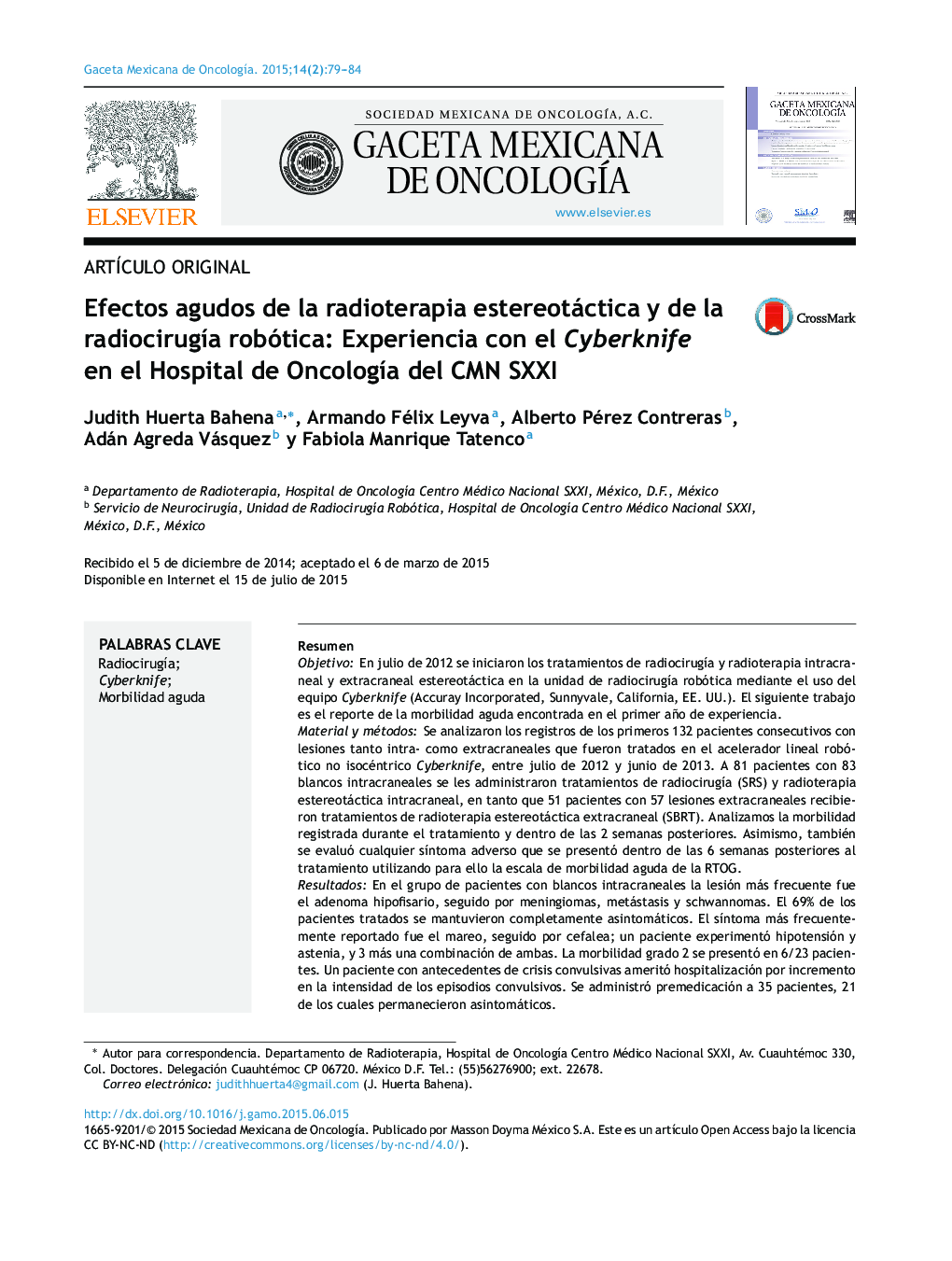| Article ID | Journal | Published Year | Pages | File Type |
|---|---|---|---|---|
| 3988604 | Gaceta Mexicana de Oncología | 2015 | 6 Pages |
ResumenObjetivoEn julio de 2012 se iniciaron los tratamientos de radiocirugía y radioterapia intracraneal y extracraneal estereotáctica en la unidad de radiocirugía robótica mediante el uso del equipo Cyberknife (Accuray Incorporated, Sunnyvale, California, EE. UU.). El siguiente trabajo es el reporte de la morbilidad aguda encontrada en el primer año de experiencia.Material y métodosSe analizaron los registros de los primeros 132 pacientes consecutivos con lesiones tanto intra- como extracraneales que fueron tratados en el acelerador lineal robótico no isocéntrico Cyberknife, entre julio de 2012 y junio de 2013. A 81 pacientes con 83 blancos intracraneales se les administraron tratamientos de radiocirugía (SRS) y radioterapia estereotáctica intracraneal, en tanto que 51 pacientes con 57 lesiones extracraneales recibieron tratamientos de radioterapia estereotáctica extracraneal (SBRT). Analizamos la morbilidad registrada durante el tratamiento y dentro de las 2 semanas posteriores. Asimismo, también se evaluó cualquier síntoma adverso que se presentó dentro de las 6 semanas posteriores al tratamiento utilizando para ello la escala de morbilidad aguda de la RTOG.ResultadosEn el grupo de pacientes con blancos intracraneales la lesión más frecuente fue el adenoma hipofisario, seguido por meningiomas, metástasis y schwannomas. El 69% de los pacientes tratados se mantuvieron completamente asintomáticos. El síntoma más frecuentemente reportado fue el mareo, seguido por cefalea; un paciente experimentó hipotensión y astenia, y 3 más una combinación de ambas. La morbilidad grado 2 se presentó en 6/23 pacientes. Un paciente con antecedentes de crisis convulsivas ameritó hospitalización por incremento en la intensidad de los episodios convulsivos. Se administró premedicación a 35 pacientes, 21 de los cuales permanecieron asintomáticos.En el mismo periodo se trató a 51 pacientes con 57 lesiones extracraneales. El diagnóstico más frecuente fue cáncer de próstata y el resto presentaba enfermedad oligometastásica o lesiones primarias en pulmón e hígado. En este grupo de pacientes, el 44% no presentó síntomas asociados al tratamiento, en tanto que 12 requirieron tratamiento sintomático; en 12 pacientes se reportó morbilidad grado 2. No se registró ningún caso de morbilidad grado 3.ConclusionesLa morbilidad aguda encontrada en el primer año de experiencia utilizando radiocirugía o radioterapia estereotáctica intra- y extracraneal es mínima y fácilmente manejable, lo cual confirma la seguridad de estos tratamientos.
PurposeOn July 2012, treatments with both intracranial and extracranial stereotactic radiotherapy, using the Cyberknife system (Accuray Incorporated, Sunnyvale, California, USA), were started at the Robotic Radiosurgery Unit. This work is the report of the acute morbidity found throughout the first year of experience.Material and methodsAn analysis was performed on the records of the first 132 consecutive patients with intra- and extracranial lesions, treated with the robotic non-isocentric linear accelerator between July 2012 and June 2013. Intracranial radiosurgery (SRS) and stereotactic radiotherapy treatments were administered to 81 patients with 83 intracranial targets, and 51 patients with 57 lesions received extracranial stereotactic radiotherapy treatments (SBRT). An analysis was made of acute morbidity occurring during the treatment, and within the 2 subsequent weeks. Additionally, any symptom occurring within 6 weeks after the treatment was also assessed using the RTOG scale for acute morbidityResultsIn the group of patients with intracranial target lesions, the most common tumour was pituitary adenoma, followed by meningioma, metastases, and schwannoma. Sixty-nine percent treated patients remained completely asymptomatic. The most frequently reported symptom was dizziness, followed by headache. One patient experienced hypotension and asthenia, and 3 other patients reported a combination of both these symptoms. Grade 2 morbidity was reported in 6 of the 23 patients. One patient with a history of seizures required hospital admission due to increased severity of the convulsive episodes. Pre-medication was given to 35 patients, out of which 21 remained asymptomatic.During the same period, 51 patients with 57 extracranial lesions were treated. The most common diagnosis was prostate cancer and the rest had oligometastases or primary lung or liver lesions. In this group of patients, 44% had no treatment-associated symptoms, whereas 12 required symptomatic treatment. Grade 2 morbidity was reported in 12 patients. There were no cases of Grade 3 morbidity.ConclusionsAcute morbidity found within the first year of experience using intra- and extracranial stereotactic radiosurgery or radiotherapy is minimal and easily manageable, which demonstrates the safety of both these treatments.
